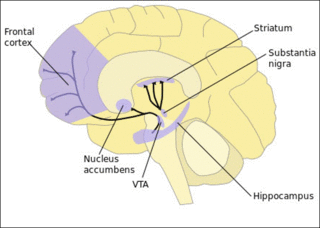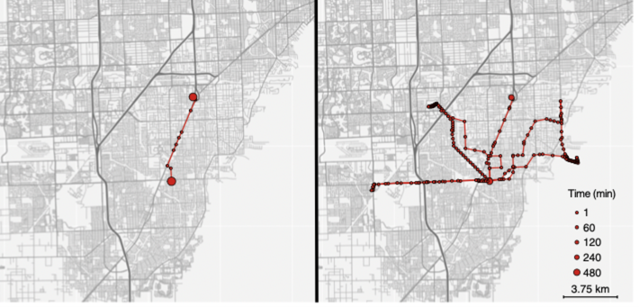Neuroscience
Why Doing Something Different Can Boost Well-Being
A neuroscience-based method to improve happiness.
Posted June 23, 2021 Reviewed by Gary Drevitch
Key points
- Experiential diversity—going to new or different places and doing different things—can boost well-being, research suggests.
- A study using geotracking of participants found that on days when they went to a wider range of places, their positive emotions were higher.
- Increasing one's range of activities or locations, especially as pandemic restrictions ease, could create an "upward spiral" of positiivty.

It has been an exhausting few months at work, and you are excited to take a break. With a few vacation days remaining, rather than lounging around the house (which was your initial plan), a friend recommends that you make some plans to road trip. Your excitement starts to build at the prospect of traveling – exploring different and potentially new locations, eating different foods, and making new memories. This does take a bit of planning, but imagine if you had just stayed at home, watching television and lying on the couch all day.
Or let’s take a somewhat more pertinent example, one relevant to the ongoing pandemic. One of the hardest things about COVID-19 is that quarantine has greatly limited our ability to pursue new experiences. Studies show that the inability to engage in our typical environments has undoubtedly endangered people’s mental health (Choi et al., 2020) — you may be able to relate to this. Nevertheless, especially for those of you who normally find it difficult to try new activities, you may have found great solace in pushing yourself to find some sort of rhythm this past year. Whether it was immersing yourself in a new hobby, setting new goals, or walking to a part of the neighborhood you’ve never been to before, finding different ways to live the day-by-day seems to be beneficial and quite refreshing to many of us.
From these examples, hopefully you can start to see how experiential diversity, or going to new (or at least different) places and/or engaging in different experiences, can improve overall well-being. This principle is quite intuitive to us since many would agree that going on vacation – or perhaps, for those who aren’t as extroverted, finding different activities to do each day – makes us happier. In more concrete terms, human experience suggests that experiential diversity may be associated with increased positive affect, which makes sense since exploration seems to be an innate human desire.

Interestingly, research on animals has shown that new experiences are beneficial. Animals that can roam freely within environments that offer diverse experiences exhibit greater cognitive well-being – in other words, they exhibit increased social activity and an enhanced ability to respond to stressful or aversive situations (Tost et al., 2015). Notably, these behavioral effects are accompanied by significant changes in brain structure and function, particularly in the neural regions responsible for memory and responding to rewarding stimuli (hippocampus and striatum regions; van Praag et al., 2000).
On the other hand, there have been few studies that looked at variation in experiential diversity and its relationship to positive affective states in humans. Encouragingly, a recent study by Heller et al. (2020) uses a GPS-like tool to look at the association between real-world experiential diversity and positive affect for humans, and the underlying neural mechanisms that may mediate this relationship. Let’s see what they found.
Tracking, Measuring, and Analyzing Experiential Diversity in Humans
Heller et al. tracked the location of participants and quantitatively measured their GPS coordinates over a day. In previous studies, this mode of geolocation tracking has been verified as a successful tool to assess experiential diversity in animals (Freund et al., 2013). Thus, the current study aimed to examine whether daily movement – while controlling for potentially confounding factors such as distance traveled, location of the participant (Miami or New York), day of the week, and temperature – could serve as an accurate assessment of experiential diversity by relating to changes in positive affect in humans.
A total of 132 participants were monitored for 3-4 months, and were asked to provide assessments of positive and negative emotions at random times throughout the day via a smartphone system. A participant’s geolocation score was higher for days in which the participant visited a greater number of locations and spent a similar time across these locations. (A minimum score would be achieved by spending all of one’s time at one location.)

Finally, at the end of the geolocation tracking period, a subset of these participants was screened for Magnetic Resonance Imaging (MRI) eligibility — a scan to examine brain activity. This was done to better understand how different parts of the brain work together in explaining the potential relationship between experiential diversity and well-being.
Diverse Experiences Increase Well-Being
As expected, the researchers found that positive emotions were higher on days when a participant’s geolocation score was greater, suggesting that daily novelty exposure is associated with well-being. It is worth noting that the researchers also sought to see whether this relationship was bidirectional – in other words, if individuals are also more motivated to explore their environments on days they are feeling better. Interestingly, in this second set of experiments, they confirmed that experiential diversity is associated with more positive emotions, and they also found that this in turn is associated with more novel and diverse experiences the next day. This is consistent with speculation that behaviors promoting positive emotions can create positive feedback loops, or “upward spirals,” that promote subsequent development of more positive emotions (Garland et al., 2010). This idea is intuitive to many of us: For example, we often want to celebrate after completing a big project or accomplishing a goal, to perpetuate the positive emotions we are experiencing.
One question remained for the researchers: How exactly does the human mind operate in this way? What is the neural explanation for our increase in positive emotions in response to experiential diversity? To answer, Heller et al. performed an MRI scan on approximately half of the participants after the geolocation tracking period. They found that the degree to which the neural regions important for memory and processing of reward/environmental novelty work together — the connectivity of the hippocampus and striatum — is associated with the relationship between experiential diversity and positive emotions.
Implications of the Study
- Increases in the daily diversity of one’s physical location were associated with increases in positive emotions, which in turn promoted subsequent development of more positive emotions.
- This effect was related to the coupling of the neural regions used in memory processing and processing of rewarding stimuli (i.e., integration of hippocampus and striatum)

From the data collected by Heller et al., we see that engaging in new and diverse real-world daily experiences may have lasting impacts on well-being. Especially in light of the slowly receding pandemic, we encourage you to take some time today, or in the next few days, to find new, different activities to experience. As quarantine measures become less strict, take that extra time to explore the city with your family, or hike that new trail nearby. Even if it sometimes takes a lot of energy to do new things, who knows how much of an “upward spiral” you’ll find yourself in?
Adam Zhang (Yale undergraduate) and Dr. Reuma Gadassi-Polack contributed to this post
References
Choi, K. R., Heilemann, M. V., Fauer, A., & Mead, M. (2020). A Second Pandemic: Mental Health Spillover From the Novel Coronavirus (COVID-19). Journal of the American Psychiatric Nurses Association, 26, 340–343. https://doi.org/10.1177/1078390320919803
Freund, J., Brandmaier, A. M., Lewejohann, L., Kirste, I., Kritzler, M., Krüger, A., Sachser, N., Lindenberger, U., & Kempermann, G. (2013). Emergence of individuality in genetically identical mice. Science (New York, N.Y.), 340(6133), 756–759. https://doi.org/10.1126/science.1235294
Garland, E. L., Fredrickson, B., Kring, A. M., Johnson, D. P., Meyer, P. S., & Penn, D. L. (2010). Upward spirals of positive emotions counter downward spirals of negativity: insights from the broaden-and-build theory and affective neuroscience on the treatment of emotion dysfunctions and deficits in psychopathology. Clinical psychology review, 30(7), 849–864. https://doi.org/10.1016/j.cpr.2010.03.002
Goodroe, S. C., Starnes, J., & Brown, T. I. (2018). The Complex Nature of Hippocampal-Striatal Interactions in Spatial Navigation. Frontiers in human neuroscience, 12, 250. https://doi.org/10.3389/fnhum.2018.00250
Tost, H., Champagne, F. A., & Meyer-Lindenberg, A. (2015). Environmental influence in the brain, human welfare and mental health. Nature neuroscience, 18(10), 1421–1431. https://doi.org/10.1038/nn.4108
van Praag, H., Kempermann, G., & Gage, F. H. (2000). Neural consequences of environmental enrichment. Nature reviews. Neuroscience, 1(3), 191–198. https://doi.org/10.1038/35044558




